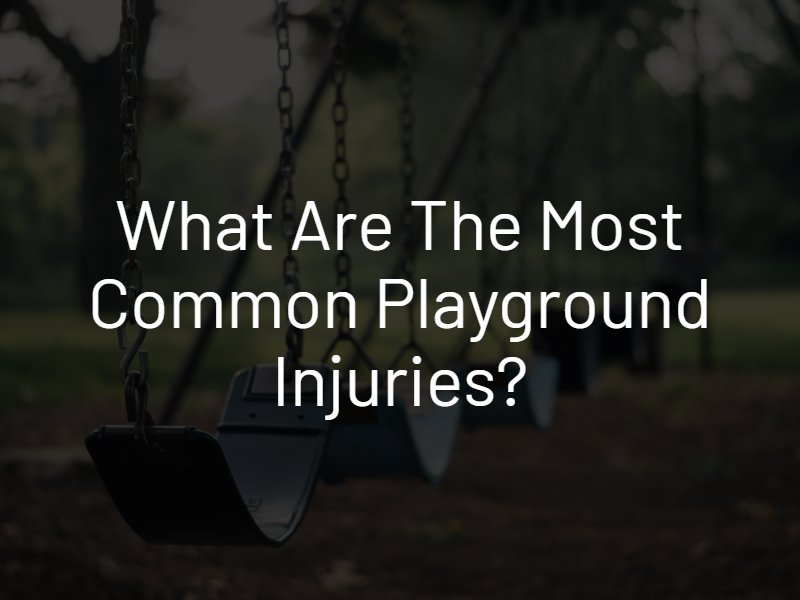
Legally Reviewed By: Robert M. Knowles
Attorney & Partner At Knowles Law Firm
A playground should be a safe place for children. It should have safety-approved equipment, well-maintained grounds and adequate child supervision. A playground should not contain hazards or defects that pose undue risks to children. Although some playground injuries arise from typical child’s play, other child injuries result from property or equipment defects. Compensation may be available for some of the most common playground injuries depending on the cause of the accident.
A playground injury lawyer in Omaha can help parents understand their rights after serious accidents.

Broken Bones
About 56% of playground injuries that require hospitalization are fractures and abrasions, according to the Centers for Disease Control and Prevention. Children’s bones are softer than adults.’ They often bend and splinter before they break (greenstick fracture). Broken bones for a child can be painful and take weeks or months to heal.
They may interfere with a child’s proper physical development. Bone fractures can happen on a playground due to falls, getting caught-in or between playground equipment, and sports incidents. A properly maintained playground with updated equipment can help prevent falls, while soft and safe ground materials can cushion a child’s fall and prevent the most serious injuries.
Head and Brain Injuries
Another common fall-related playground injury is a head or brain injury. The number of emergency room visits for playground brain injuries has dramatically increased in the last decade. A child could fall and strike his or her head on playground equipment or the ground surface due to dangerous or faulty structures.
Poorly constructed or maintained equipment could increase the risk of serious fall accidents on a playground. Inadequate supervision can also lead to falls and head injuries. A child climbing where he or she should not be, such as on top of a structure, for example, could lead to a serious fall and a traumatic brain injury.
Soft-Tissue Injuries
A child could suffer a soft-tissue injury such as a torn muscle, sprain or dislocation on a playground due to rough play and lack of child supervision. If the playground equipment is poorly maintained or old, it could have issues that lead to soft-tissue injuries.
Wood rot could cause a playground structure to collapse, for example, or ropes could grow frail and cause a fall injury. Slippery or dangerous surfaces could also cause slip and fall accidents with accompanying soft-tissue damage.
Cuts, Scrapes and Lacerations
Unsafe, old or broken playground equipment can lead to severe lacerations for a child. Rusty or jagged metal on a slide, for instance, could badly injure a child and expose him or her to risks of complications such as infections or tetanus. Bad lacerations can also require sutures and cause permanent scars.
Other risks can include exposed screws, loose bolts, protruding nails, sharp edges and dangerous sticks on the ground. It is the owner of the playground’s legal responsibility to inspect equipment and the grounds for laceration hazards before opening it to children.
Strangulation and Entrapment
One of the most dangerous risks children face on unsafe playgrounds is that of strangulation. During a Consumer Product Safety Commission investigation of fatal playground accidents, it found 68% of the children died from strangulation. Strangulation can occur on rope structures and swings.
Play equipment such as jump ropes can also lead to child strangulation. Entrapment is another significant risk on a playground. A child could receive a serious entrapment injury if the playground has design or manufacturing defects that allow the child to get stuck, crushed or pinched between equipment.
Who Is Liable for a Playground Injury?
Playground injuries can be extremely serious and even fatal for victims. The parents of a severely injured child may be able to bring a premises liability lawsuit against one or multiple parties for the playground accident in Nebraska. The liable party might be the school or city in charge of playground maintenance if equipment disrepair caused the injury.
A school or organization could also be liable if guilty of poor playground supervision. In other cases, the manufacturer of the playground equipment could be liable for dangerous product defects. The manufacturer has a responsibility to design and create reasonably safe equipment.

About Our Attorney
Robert M. Knowles
Attorney & Partner at Knowles Law Firm
Robert has tried cases in both state and federal courts and was selected as one of the top 100 litigation lawyers in Nebraska for 2014 by the American Society of Legal Advocates. Less than 1.5 percent of lawyers nationally are selected for this recognition. He is rated AV by Martindale-Hubbell which is the highest rating an attorney can obtain. He was also selected by Martindale-Hubbell as a 2019 Top Rated Lawyer.


 Menu
Menu
